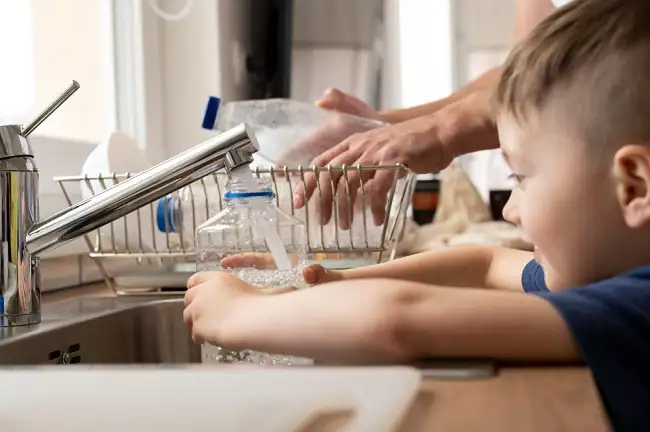Imagine pouring a glass of water from your tap, expecting it to be fresh and clean, only to find it tastes off or smells strange. For many homeowners and health-conscious consumers, this scenario underscores the critical importance of water quality in our daily lives.

In this blog post, we’ll explore why water quality matters, how you can identify potential issues, and practical steps you can take to ensure the water in your home is safe and refreshing.
Understanding Water Quality The Basics
Water quality refers to the chemical, physical, and biological characteristics of water, typically concerning its suitability for a particular purpose like drinking, cooking, or bathing. High-quality water should be free of harmful contaminants, have a neutral taste, and be clear and odorless. Several factors affect water quality, including the source of the water, natural and human-made contaminants, and the treatment processes it undergoes.
Knowing what constitutes good water quality is the first step in ensuring your household has access to safe and healthy water. The Environmental Protection Agency (EPA) provides guidelines and standards for drinking water quality to help consumers understand what to look for. These standards cover various contaminants such as bacteria, viruses, heavy metals, and chemicals that can pose health risks.
Understanding the basics of water quality helps you make informed decisions about testing and improving your household water. In the following sections, we’ll discuss the signs of poor water quality, common contaminants, and effective solutions for addressing these issues, including finding the best water softener for Utah .
Signs Your Water Quality Might Be Poor
One of the most crucial aspects of maintaining good water quality in your home is recognizing the signs of potential problems. Here are some common indicators that your water quality might be compromised:
Unpleasant Taste or Odor
If your tap water has a metallic, chlorine, or sulfur-like smell, it could indicate the presence of contaminants. These odors often result from chemicals used in water treatment or naturally occurring substances in the water supply.
Discoloration
Water that appears cloudy, yellow, brown, or has visible particles can signal contamination. Discoloration may result from rusting pipes, sediment, or the presence of organic materials and bacteria.
Health Symptoms
Experiencing gastrointestinal issues, skin irritation, or other unexplained health problems after using tap water can be a sign of water contamination. If multiple household members experience these symptoms, it’s essential to investigate further and test your water.
Common Water Contaminants Found in Homes
Understanding the types of contaminants that can affect your water quality is essential for taking the right steps to address them. Here are some common water contaminants found in homes:
Bacteria and Viruses
Microorganisms like E. coli, coliform bacteria, and viruses can enter the water supply through sewage leaks, agricultural runoff, or untreated water sources. These pathogens can cause serious illnesses if ingested.
Heavy Metals
Elements like lead, mercury, arsenic, and cadmium can contaminate water through natural deposits or industrial pollution. Heavy metals pose significant health risks, including neurological damage and cancer.
Chemicals and Pesticides
Chemicals from industrial processes, agricultural runoff, and household cleaning products can find their way into your water supply. Pesticides, herbicides, and chemicals like chlorine and fluoride can affect water taste, odor, and safety.
Solutions to Improve Water Quality
Now that you understand the potential issues affecting your water quality, let’s explore some effective solutions to ensure your home’s water is safe and clean.
Installing Water Filtration Systems
One of the most effective ways to improve water quality is by installing a water filtration system. There are several types of filtration systems to choose from, depending on your needs and budget:
- Activated Carbon Filters: These filters use carbon to remove impurities, chlorine, and odors from your water. They are commonly used in countertop and under-sink units.
- Reverse Osmosis Systems: These systems use a semi-permeable membrane to remove contaminants, including heavy metals, chemicals, and microorganisms. Reverse osmosis systems are highly effective but can be more expensive.
- UV Purifiers: Ultraviolet purifiers use UV light to kill bacteria and viruses in the water. These systems are often used in conjunction with other filtration methods for comprehensive water treatment.
Regular Maintenance and Testing
Maintaining your water filtration system and regularly testing your water quality are essential steps to ensure ongoing safety and cleanliness. Here are some tips for effective maintenance and testing:
- Replace Filters: Follow the manufacturer’s recommendations for replacing filters in your water filtration system. Regular replacement ensures optimal performance and extends the life of your system.
- Conduct Regular Testing: Use at-home water testing kits or hire a professional to test your water quality periodically. Testing can help identify potential issues early and guide necessary adjustments to your filtration system.
- Check for Leaks and Repairs: Inspect your plumbing and water filtration system for leaks or damage. Promptly address any issues to prevent contamination and maintain water quality.
Eco-Friendly Water Quality Improvement Tips
In addition to using technology to improve water quality, there are eco-friendly practices you can adopt to protect and enhance your water supply:
- Reduce Chemical Use: Minimize the use of chemical cleaning products and pesticides in and around your home. Opt for natural alternatives to reduce the risk of contamination.
- Conserve Water: Implement water-saving practices like fixing leaks, using low-flow fixtures, and collecting rainwater for gardening. Conserving water helps maintain the overall quality of your local water supply.
- Support Local Water Protection Efforts: Get involved in community efforts to protect local water sources. Support policies and initiatives that promote clean water and reduce pollution.
The Health Benefits of High-Quality Water
High-quality water is essential for maintaining good health and well-being. Here are some key benefits of ensuring your home has access to clean and safe water:
Improved Digestion and Hydration
Clean water aids in digestion and helps your body absorb nutrients more effectively. Proper hydration supports overall bodily functions, including temperature regulation, joint lubrication, and waste elimination.
Enhanced Skin and Hair Health
Using high-quality water for bathing and washing can improve the health and appearance of your skin and hair. Contaminants in water can cause dryness, irritation, and damage, while clean water helps maintain moisture and natural oils.
Reduced Risk of Illness
Drinking and using clean water reduces the risk of waterborne diseases and other health issues caused by contaminants. Ensuring your water is free of harmful substances protects you and your family’s health.
Conclusion
Improving water quality in your home is a crucial step toward ensuring the health and well-being of your household. By understanding the basics of water quality, recognizing signs of potential issues, and implementing effective solutions, you can enjoy the benefits of clean and safe water.







